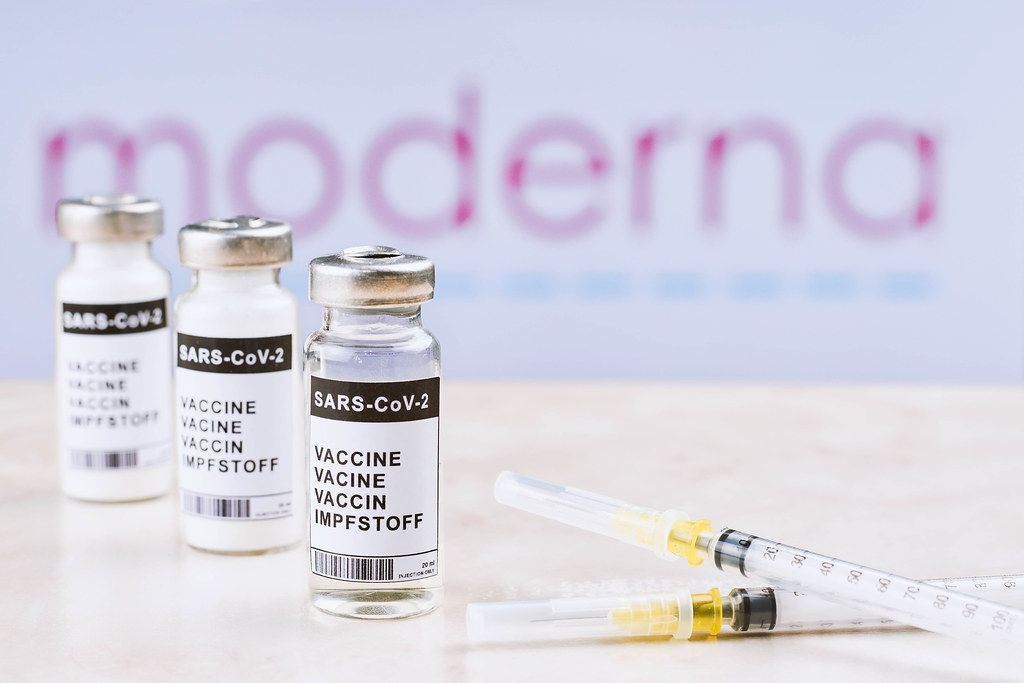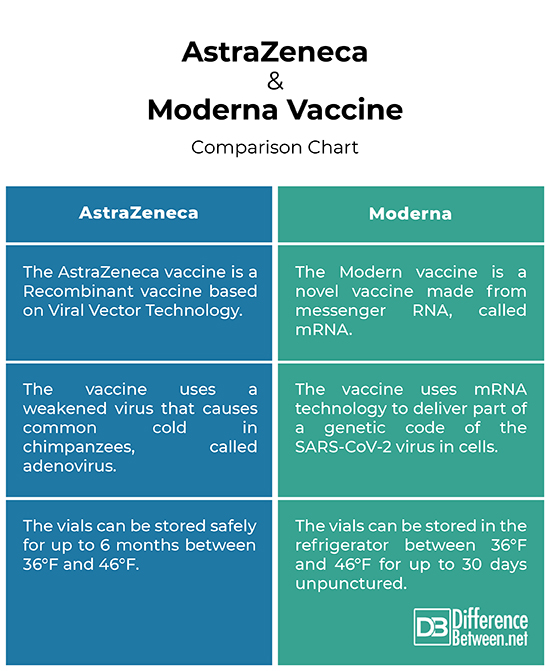Difference Between AstraZeneca and Moderna
A COVID-19 vaccine could be considered effective if it satisfies two conditions – either it prevents people from getting infected or suppresses the severity of the infection if someone gets infected. All the vaccine candidates have gone through three trial phases. A key indicator of the effectiveness of the vaccine is a robust and durable immunogenic response. According to the U.S. Food and Drug Administration (FDA) guideline, a COVID-19 vaccine needs to be at least 50% effective in placebo-controlled trials. After months of clinical trials and thanks to the efforts of scientists who have been working days and nights to develop a vaccine to curb the spread of the current pandemic, we have now many vaccine candidates that are approved for emergency use. Two such strong vaccine candidates for COVID-19 that are already in distribution are AstraZeneca and Moderna.

What is AstraZeneca Vaccine?
AstraZeneca COVID-19 vaccine is developed by the University of the Oxford in collaboration with AstraZeneca, a global pharmaceutical company headquartered in Wilmington, Delaware. Codenamed AZD1222, the AstraZeneca vaccine is one of the leading COVID-19 vaccine candidates that has undergone extensive clinical trials across multiple countries including India and the United States. The Oxford vaccine candidate has shown good results in the phase I and phase II clinical trials, followed by phase III clinical trials, concluding that the vaccine offers double immunity, as a result of which it has been approved for emergency use. In fact, many countries have already started inoculating the population and many have already vaccinated with the first dose.
However, many patients after receiving the dose have reported signs of blood clotting, fearing which many nations including Germany, Italy, France, Iceland and Denmark have suspended the administration of the vaccine. The European Medicines Agency (EMA) denies any severe side effects and says that the vaccine is safe to use and the long term benefits outweigh the potential side effects. The Oxford vaccine candidate uses a virus called an adenovirus which is of a chimpanzee and not human. It’s a weakened virus that causes common cold in chimpanzees and it’s genetically modified to make it possible to grow in humans.

What Is Moderna Vaccine?
The Moderna COVID-19 vaccine, codenamed mRNA-1273 is one of the first few vaccine candidates to be approved for emergency use by the FDA to curb the ongoing pandemic. The preliminary results suggested an efficacy rate of 94.5% against the COVID-19 infection with no severe allergic reactions. Like the Pfizer vaccine, Moderna’s vaccine is also an mRNA-based vaccine meaning it uses messenger RNA to provide instructions for our cells to make that spike protein of the coronavirus which the body then mount an immune response against. The mRNA vaccine technology is a novel technology for vaccine development that offers several advantages over other vaccine technologies in terms of efficacy, stability and speed of development.
The company has synthesized part of the virus RNA and embedded this RNA in lipid nanoparticles. The mRNA takes messages from the virus genes to the infected host cell, instructing the cell to make specific proteins. It then tells the host cell to make the spike protein which exists in the spike the virus uses to enter a person’s cells. When injected, it instructs our cells to make antibodies against this spike protein, which in turn stops the virus from getting into our cells.
Difference between AstraZeneca and Moderna
Type of AstraZeneca and Moderna
– The Oxford-AstraZeneca COVID-19 vaccine is a Recombinant vaccine candidate that uses a replication-deficient simian adenovirus vector to deliver recombinant SARS-CoV-2 spike protein genes. The virus is actually a weakened virus that causes common cold in chimpanzees and it carries a small portion of the genetic material of the SARS-CoV-2 spike protein and injects it into our cells to induce an immune response.
The Moderna COVID-19 vaccine, on the other hand, is a novel vaccine made from messenger RNA, called mRNA and the company has synthesized part of the virus RNA and then embedded this RNA in lipid nanoparticles. When injected, the mRNA tells the host cell how to make the spike proteins so that the cells produce antibodies against this spike protein, eventually stopping the virus from getting into our cells.
Efficacy of AstraZeneca vs Moderna
– According to the data based on clinical trials produced by the manufacturer, the Oxford-AstraZeneca COVID-19 vaccine reportedly showed an efficacy rate of almost 62% when the complete dosage is placed at least a month apart. One dose regimen showed a 90% effectiveness rate against the infection when given as a half dose, followed by a full dose placed a month apart. The Moderna vaccine, on the other hand, has shown an astonishing 94.5% efficacy rate, which is a startling number compared to other vaccine candidates. The results were based on clinical trials of over 30,000 participants being tested across several sites in the United States.
Dose & Storage for AstraZeneca vs Moderna
– Moderna vaccine is to be administered twice, 28 days apart. So, if the first dose is on day 1, then the second dose is on day 29, which is an additional week compared to AstraZeneca vaccine. The Moderna vaccine vials can be stored in the refrigerator between 36°F and 46°F for up to 30 days unpunctured. The AstraZeneca COVID-19 vaccine, on the other hand, can be stored safely for up to 6 months between 36°F and 46°F. Based on some new analysis data, the vaccine is believed to be more effective if there’s a 12 week gap between the two doses.
AstraZeneca vs. Moderna Vaccine: Comparison Chart

Summary
While both AstraZeneca and Moderna are among the leading COVID-19 vaccine candidates, the mRNA-based Moderna vaccine has a slight edge in efficacy. Based on preliminary results, the Moderna vaccine is believed to be about 95% effective against the COVID-19 infection, which is a startling number compared to what the AstraZeneca vaccine claims. The main difference the two vaccines is obviously how the two vaccines work. The AstraZeneca vaccine is a Recombinant vaccine based on Viral Vector technology, whereas the Moderna vaccine is an mRNA vaccine, which is a novel technology for vaccine development.
- Difference Between Caucus and Primary - June 18, 2024
- Difference Between PPO and POS - May 30, 2024
- Difference Between RFID and NFC - May 28, 2024
Search DifferenceBetween.net :
1 Comment
Leave a Response
References :
[0]Cabot, Sandra. Corona and Other Dangerous Viruses. Arizona, United States: SCB Inc, 2020. Print
[1]Akpan, Nsikan. “Moderna's MRNA Vaccine Reaches Its Final Phase. Here's How It Works.” National Geographic, National Geographic Partner, LLC., 28 July 2020, www.nationalgeographic.com/science/2020/05/moderna-coronavirus-vaccine-how-it-works-cvd/. Accessed 21 Mar. 2021
[2]Romanowski, Victor. Current Issues in Molecular Virology: Viral Genetics and Biotechnological Applications. London, United Kingdom: Intech Open, 2013. Print
[3]Image credit: https://live.staticflickr.com/65535/50714710662_2294dc2d63_b.jpg
[4]Image credit: https://commons.wikimedia.org/wiki/File:Oxford_AstraZeneca_COVID-19_vaccine_(2021)_I.jpg

Which one is the best Vaccine AstraZeneca, Moderna, or Fizer? I am very confused about it. Which one is best for me. I have an option to give Sinofirm vaccine, but I did not allow to take Sinofirm.